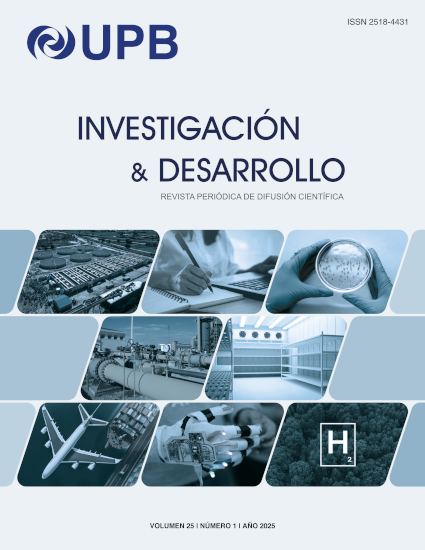DISEÑO DE UNA HERRAMIENTA PARA LA ESTIMACIÓN DE LA CARGA TÉRMICA Y DEMANDA ENERGÉTICA EN CÁMARAS DE REFRIGERACIÓN
DOI:
https://doi.org/10.23881/idupbo.025.1-6iPalabras clave:
Consumo Energético, Cámaras Frigoríficas, Carga Térmica, Automatización, CalorResumen
La refrigeración es clave para conservar alimentos, reducir pérdidas y mejorar la competitividad de los sectores productivos, especialmente de la pequeña y mediana empresa (PyMES). Esta necesidad es aún más evidente en países como Bolivia, donde la falta de sistemas adecuados de refrigeración y almacenamiento limita el aprovechamiento de los picos de cosecha, generando sobreproducción estacional y significativas pérdidas económicas por la incapacidad de conservar los productos. En este contexto, el presente trabajo propone el desarrollo de una herramienta automatizada y de uso amigable que permite estimar de manera preliminar la carga térmica y la demanda energética de cámaras frigoríficas a partir de datos básicos como dimensiones, tipo de producto y condiciones climáticas locales. La herramienta considera todos los aportes térmicos relevantes (calor sensible, latente, pérdidas por transmisión, infiltración y cargas internas), y estima la potencia frigorífica y el consumo energético en función del tiempo de operación. Adicionalmente, se realizó su validación mediante un estudio de caso donde demostró una desviación mínima respecto a una cotización real, demostrando su confiabilidad como apoyo en el pre-diseño de sistemas de refrigeración destinados a sectores productivos con recursos y conocimientos técnicos más limitados.Descargas
Referencias
[1] J. A. Fuentes Martínez y J. M. Rodríguez Sánchez, Instalaciones frigoríficas, 6.a edición, Madrid, España: Paraninfo, 2004.
[2] Y. A. Çenjel y M. A. Boles, Termodinámica, 8.a ed. McGraw-Hill / Interamericana Editores S.A. de C.V., 2015.
[3] Y. A. Çenjel y A. J. Ghajar, Heat and Mass Transfer, 5.a ed. New York, NY, Estados Unidos: McGraw-Hill Education, 2011.
[4] A. Anchundia et al., Bitácora Académica USFQ, vol. 15. Quito, Ecuador: USFQ PRESS, 2024.
[5] E. S. Castro M., Propiedades Térmicas de los Alimentos. en Monografías sobre Ingeniería de Alimentos, no. 8. Chile: Universidad de Chile, 1986.
[6] M. W. Zemansky, H. D. Young, y F. Weston Sears, University Physics, 8.a edición. Reading, Massachusetts, USA: Addison-Wesley, 1987.
[7] W. F. Stoecker, Industrial Refrigeration Handbook. New York, USA: McGraw-Hill, 1998.
[8] P. Luna Luna, «Proyecto de Quesería Industrial en el Polígono Industrial de Manzanares, Parcela 88, C/ XII, (Ciudad Real)», Universidad de Castilla La Mancha, 2005.
[9] Electrofrio, Cotización comercial del sistema de refrigeración de 3000 kg/día de açaí, 28 de marzo, 2025.
[10] Bohn, Manual de ingeniería, H-ENG-1 APM. México, D.F.: Frigus Bohn S.A. de C.V., 2005.
Descargas
Archivos adicionales
Publicado
Número
Sección
Licencia
Derechos de autor 2025 Rodrigo Antonio Paz-Soldán, Renán Jorge Orellana-Lafuente, Miguel Hernán Fernández-Fuentes, Daniel Felipe Sempértegui-Tapia

Esta obra está bajo una licencia internacional Creative Commons Atribución-NoComercial-CompartirIgual 4.0.
Reconocimiento-NoComercial-CompartirIgual
CC BY-NC-SA
Esta licencia permite a otros entremezclar, ajustar y construir a partir de su obra con fines no comerciales, siempre y cuando le reconozcan la autoría y sus nuevas creaciones estén bajo una licencia con los mismos términos.
Los autores pueden realizar acuerdos contractuales adicionales separados para la distribución no exclusiva de la versión publicada del artículo publicado en la revista (por ejemplo, publicarlo en un repositorio institucional o en un libro), sujeto a un reconocimiento de su publicación inicial en esta revista
